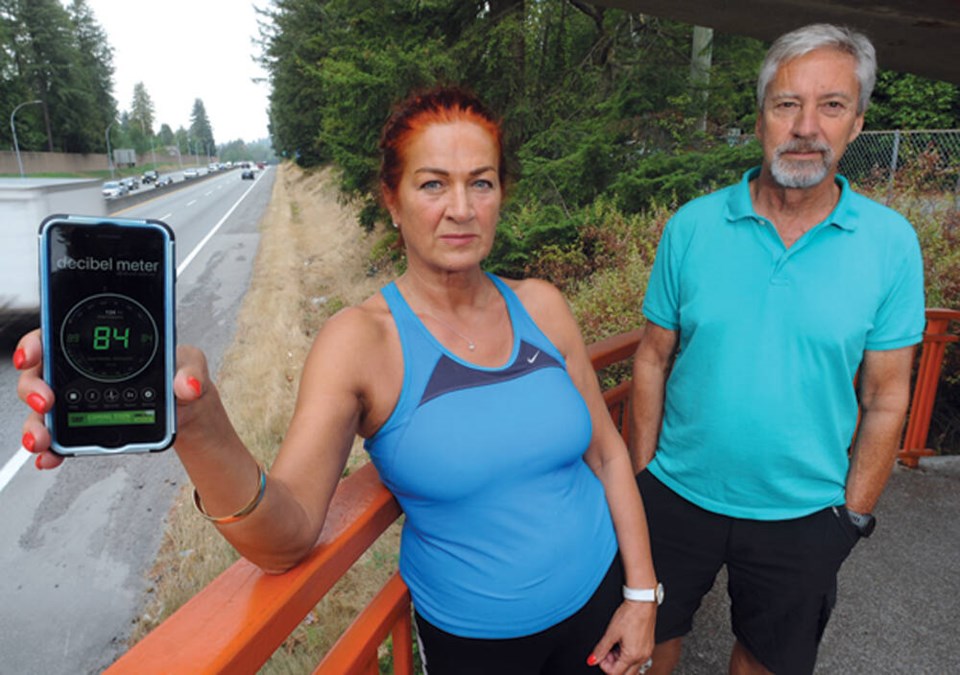In order to have a conversation in their backyards, Gladwin Drive residents have to shout to be heard. In their front yards? Don’t even bother.
For almost three decades, residents in the Lionsview neighbourhood, just 20 metres from the Upper Levels Highway, have been asking the Ministry of Transportation and Infrastructure to install a sound barrier.
“From the Second Narrows Bridge, all the way to West Vancouver, it’s all sound barriers except our little portion. Are we second-class citizens? Do we not pay our taxes?” asked Olga Campeanu, who has lived on Gladwin since 2000.
The Upper Levels Highway opened in 1964, meaning it predates most of the current residents. But, no secret to anyone, the traffic volume and noise has only increased, neighbours say.
“It’s gotten ridiculous. The fact is that these people driving through on the freeway have no idea that they’re actually in a residential neighbourhood,” said Michael Blanchet.
The highway cacophony isn’t just an annoyance, it’s a matter of public health. Sustained exposure to noise of more than 70 decibels can lead to hearing damage. Outside their homes, the racket registered on a smartphone-based decibel reader shows sound levels swinging between 70 and 80 decibels. Passing motorcycles and trucks are enough to wake them from sleep. Truckers routinely use their engine brakes through the area, even though it’s illegal.
“It’s a lot more stressful,” Campeanu said.
Residents west of Westview Drive have been raising a ruckus about the noise pollution to the ministry for years but their requests have fallen on deaf ears, so to speak.
“We knocked on closed doors. Nobody wanted to listen to us,” Campeanu said.
In response to a request for comment from the North Shore News, the ministry released a statement that Gladwin’s residents are sadly familiar with.
“The ministry’s noise policy states that new sound reduction measures are considered when new highways are constructed or when existing highway infrastructure is upgraded. Sound barriers were installed on the south side of Highway 1 (opposite Gladwin Drive) when the eastbound highway shoulder was widened in 2012,” it read. “Should this stretch of Highway 1 be expanded in the future, sound barriers will be considered.”
But that is lousy criteria, argues Grant O’Byrne, who has been writing to the ministry and his MLAs about the matter going back to 1997.
“They’re relying on that certain box being ticked. They don’t have any responsibility. But, come on, [the noise] is getting greater and greater,” he said.
Ironically, the addition of a sound barrier on the south side of the highway in 2012 only sent more sound waves reverberating north into Gladwin residents’ homes and yards, residents say.
West Vancouver-Capilano BC Liberal MLA Karin Kirkpatrick said has not heard directly from Gladwin’s residents since she took office, but she has reviewed the issue and agrees that the ministry’s criteria ignore cumulative growth.
“The ministry is also predicting continued traffic growth of around 40 per cent in the coming years,” she said in a statement to the North Shore News. “I frequently walk my dog along Gladwin Drive and can attest to a consistent and noticeable rumble of traffic, exacerbated by increased heavy truck traffic. I further understand constituents' feeling of inequity, as there is a sound barrier on the south side of the highway – meant to buffer the identical sound from the same highway.”



